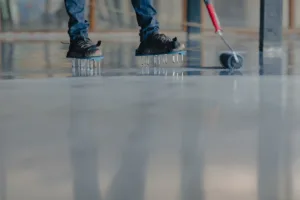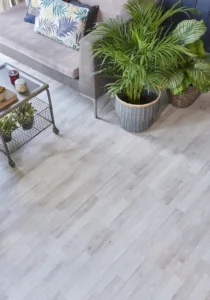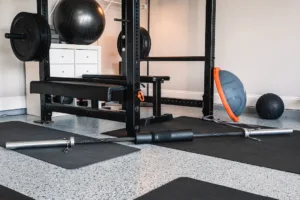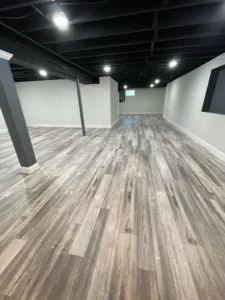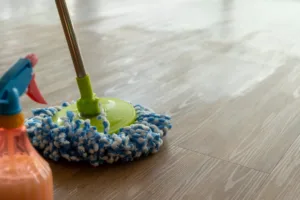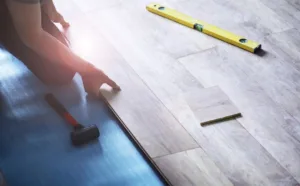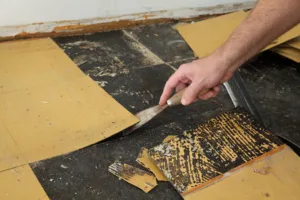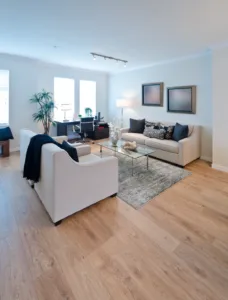Flooring is an essential aspect of any home or business. It is an investment that should be durable, practical, and stylish. Vinyl flooring is a popular choice due to its versatility and affordability, but did you know that it has a rich and fascinating history? In this blog post, we will take a trip down memory lane and explore the evolution of vinyl flooring. As both an installer and supplier of quality Vinyl materials, we thing its important to know the roots of the product.
The Origins of Vinyl Flooring
Vinyl flooring was first introduced in the 1930s. The initial materials used for its production were crude, and the methods rudimentary. However, even with these humble beginnings, vinyl flooring demonstrated potential for its durability and affordability.
The Early Days
The early versions of vinyl flooring were primarily composed of vinyl resin, along with fillers, plasticizers, and pigments. This combination resulted in a product that was somewhat rigid and lacked the design versatility we associate with vinyl flooring today. However, even at this stage, vinyl flooring had unique qualities that set it apart from other flooring options of the time.
Durability
One of the key selling points was its durability. Unlike other popular flooring choices like wood or tiles, early vinyl flooring was resistant to both water damage and wear-and-tear. This made it an ideal choice for high-traffic areas within homes and commercial properties and a reason for companies and manufacturers to continue advancing this technology.

Affordability
Another factor that contributed to the early appeal of vinyl flooring was its affordability. The materials used in its production were cost-effective, making it a more budget-friendly option compared to other flooring types. This feature was particularly attractive during the economic instability of the 1930s, as homeowners and businesses alike sought ways to reduce expenses.
Getting To Where We Are Today
Despite its humble beginnings and the simplicity of its early designs, vinyl flooring demonstrated immense potential. Over the coming decades, this potential would be harnessed through technological advancements and design innovations, propelling vinyl flooring to new heights of popularity and versatility.
Vinyl Flooring in the Mid-20th Century
By the mid-20th century, technological advancements had led to significant improvements in vinyl flooring manufacturing. The quality of the flooring improved, and a wider range of design possibilities emerged. Vinyl flooring quickly became a favorite in both residential and commercial properties and was known for its versatility and practicality.

Technological Advancements and Design Innovations
Over the next few decades, the manufacturing process of vinyl flooring continued to evolve and improve. Technological advancements allowed for more textures, patterns, and designs, providing an array of styles that could mimic other materials such as stone and hardwood floors convincingly.
Expanding Textures and Patterns
One of the major improvements was the ability to create a wider variety of textures and patterns. Previously, vinyl flooring had been relatively plain and basic, but technological advancements allowed for the incorporation of intricate details and varied surface finishes. This meant that consumers could now choose from options like smooth, ribbed, or even embossed vinyl flooring, paving the way for greater customization and personalization in interior design.
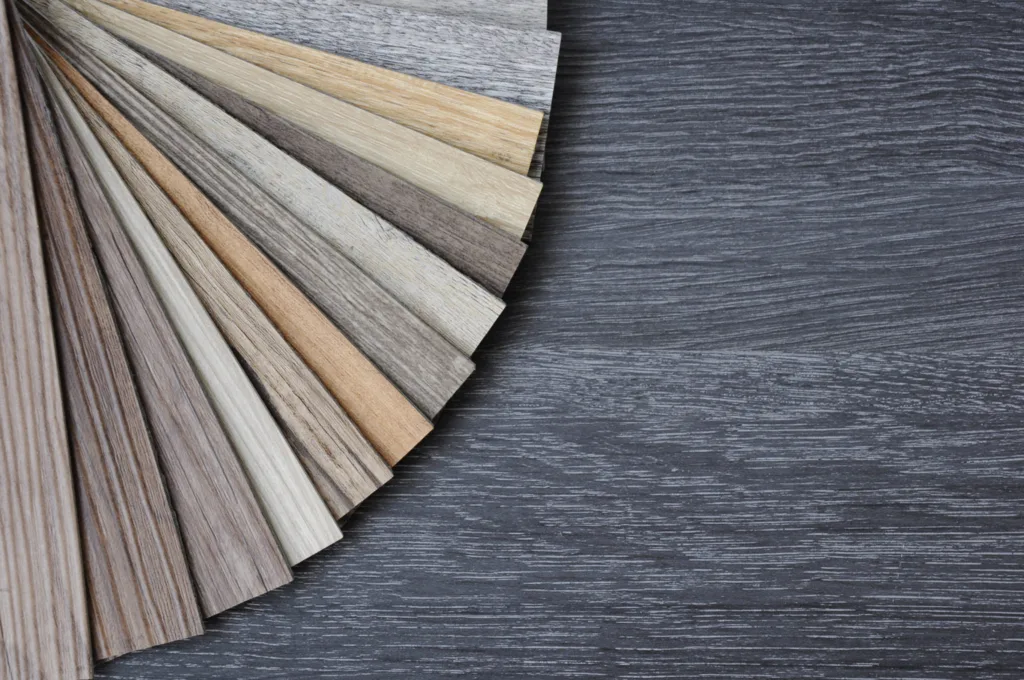
Mimicking Natural Materials
Another groundbreaking development in vinyl flooring manufacturing was the ability to convincingly mimic other materials. Advanced printing techniques enabled manufacturers to replicate the look of natural materials such as stone and hardwood. This was a game-changer, as it allowed homeowners and businesses to enjoy the aesthetic appeal of these traditionally more expensive materials, without having to contend with their associated cost and maintenance challenges.
Design Versatility
The progress in vinyl flooring manufacturing also resulted in unprecedented design versatility. With the ability to recreate a myriad of patterns and textures, vinyl flooring could now cater to a wide spectrum of design preferences – from traditional and rustic to modern and sleek. This versatility further solidified vinyl flooring’s position as a preferred choice for many, offering both functionality and style in one affordable package.
The Rise of Luxury Vinyl Tile (LVT) or Plank (LVP)
The early 21st century saw the emergence of Luxury Vinyl Tile or Plank , which would become a game-changer in the vinyl flooring market. LVT offers a wide range of versatile designs, improved durability, and finishes that mimic hardwood or stone flooring seamlessly. LVT or luxury vinyl plank (LVP) can now be found in high-end homes, office buildings, and luxury resorts worldwide.
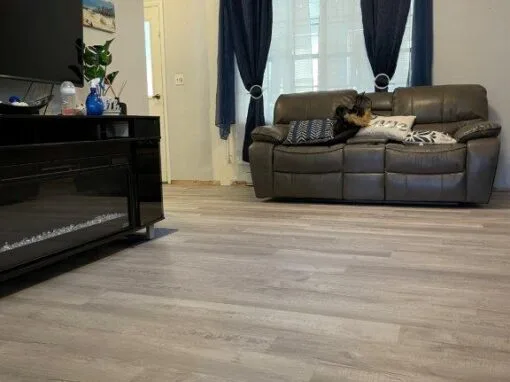
Mimicry of Hardwood and Stone
Another notable feature of LVT and LVP is their ability to seamlessly mimic hardwood and stone flooring. Through advanced printing techniques, these products can recreate the visual appeal of these traditionally more expensive materials, offering an affordable alternative without compromising on style.
LVT and LVP in High-End Properties
Today, LVT and LVP are not just confined to residential settings but have found their way into high-end homes, office buildings, and luxury resorts worldwide. Their combination of design versatility, durability, and affordability has made them a popular choice among property owners and interior designers alike.
The Next Level
In summary, the emergence of LVT and LVP has significantly broadened the scope of possibilities in vinyl flooring. As they continue to evolve and improve, we can expect to see even more innovative and stylish options in the future.
A Great Option and An Ever-Growing Technology
From its early and crude beginnings, vinyl flooring has come a long way, becoming a practical, long-lasting and stylish flooring option that’s affordable for many. Significantly, vinyl flooring has continued to evolve over time, keeping up with the changing tastes and preferences of customers. Today, vinyl flooring is a great option for anyone looking for a stylish, durable and practical flooring option. As you consider your flooring options, keep in mind the brief history of vinyl flooring and the immense benefits it offers.
The Future of Vinyl Flooring
Looking ahead, the future of vinyl flooring is poised for further innovation and transformation. Two key areas that are expected to shape the direction of this industry are increasing environmental consciousness and the technological advancements set to redefine production processes.
Embracing Sustainability
Sustainability has become a growing concern in all industries, and the flooring sector is no exception. As awareness of environmental issues increases, there’s an anticipated shift towards more eco-friendly production methods in the manufacturing of vinyl flooring.
- The use of recycled or renewable materials in the production process.
- Efforts to reduce the carbon footprint associated with manufacturing.
- Exploration of more sustainable disposal methods.
- Implementation of recycling programs for old vinyl flooring.
- Minimization of waste production.
- Promotion of circular economy principles.
Technological Advancements
The future of vinyl flooring also promises further technological advancements. These could range from improvements in the realism of the designs, such as 3D printing techniques that can more accurately mimic natural materials, to advancements in the durability and longevity of the product.
In addition, technological developments could lead to more efficient production processes, reducing costs and making vinyl flooring even more accessible to a broader market segment.
Adaptability to Changing Trends
Given its versatility and affordability, vinyl flooring is well-positioned to adapt to changing trends in interior design. As consumer preferences evolve, manufacturers of vinyl flooring will likely continue innovating to meet these changing needs, whether that means new colors, patterns, or textures.
In summary, the future of vinyl flooring looks promising, with sustainability, technological advancements, and adaptability at the forefront. As we move forward, these factors will continue to shape the industry, pushing the boundaries of what’s possible with vinyl flooring.
From Humble to Hip: The Inspiring Evolution and Bright Future of Vinyl Flooring
In conclusion, vinyl flooring, with its roots in the 1930s, has not only stood the test of time but has also adapted and evolved to become a stylish and practical choice for various spaces. Its ongoing popularity is a testament to its versatility and appeal, and it’s poised for an exciting future.
With advancements in technology and an increasing focus on sustainability, vinyl flooring is set to continue its journey of innovation, meeting the evolving needs and tastes of consumers. From humble beginnings to a promising future, the story of vinyl flooring is truly an inspiring tale of evolution and resilience.


